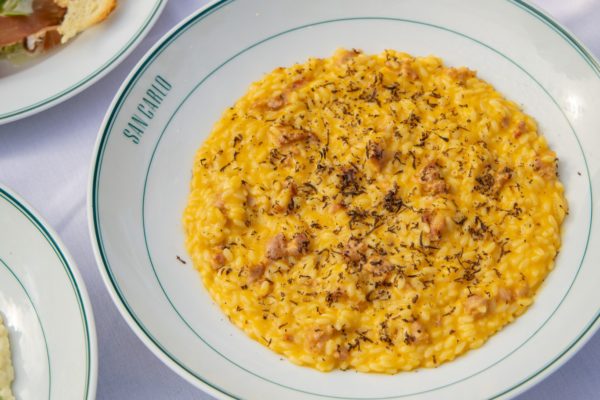A Guide to Pasta Portions: How Much Pasta Per Person?
At San Carlo, we live and breathe pasta. It’s more than a dish – it’s a way of life. Whether you’re preparing an Italian-style three-course meal or making pasta the star of the show, understanding pasta portion sizes is key to creating a satisfying and balanced experience. In this guide, we’ll answer the common questions: How much pasta per person? How much spaghetti per person? How much dry pasta per person? We’ll break it down by pasta type, shape and meal context.
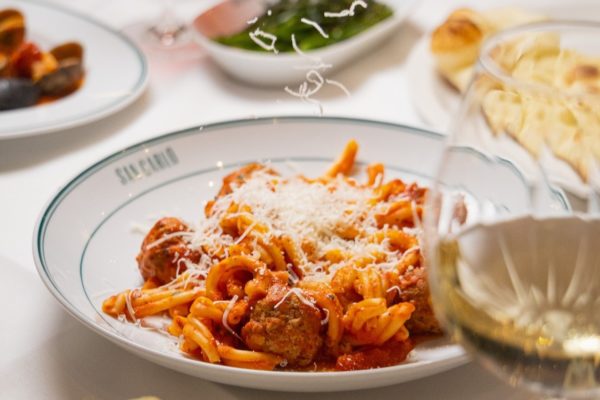
How Much Pasta Per Person? Understanding the Basics
The right pasta portion size depends on several factors – who you’re serving, the type of pasta and whether it’s part of a multi-course meal (i.e. the Italian way), or as the main event.
Italian-style portions (as part of a 3-course meal):
- Dry pasta: 75g
- Fresh pasta: 100g
- Filled pasta: 100-125g
- Specialty pasta (gnocchi, orzo): 80g
UK-style portions (where pasta is the main course):
- Dry pasta: 100-120g
- Fresh pasta: 125-150g
- Filled pasta: 150-175g
- Specialty pasta: 100-120g
Top Tip: Always measure dry pasta by weight (grams) for accuracy. Cup measurements vary depending on the pasta shape.
How Much Dry Pasta Per Person?
Dry pasta is the most commonly used type in home kitchens. It’s versatile, easy to store and perfect for almost every pasta dish.
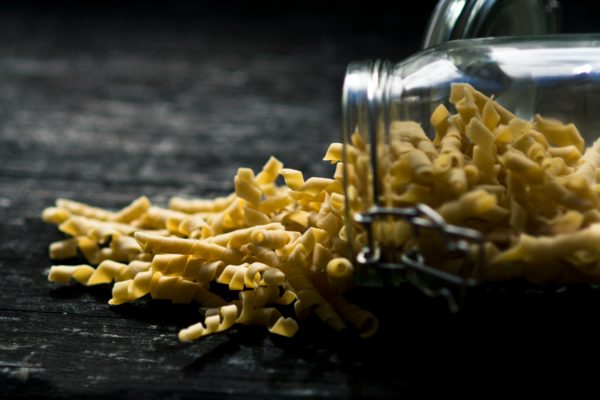
Short Pasta (Penne, Fusilli, Rigatoni)
- Italian-style portion: 75g
- UK-style portion: 100-120g
Because short pasta takes up more space, it may seem like more – but weight remains the most reliable measurement.
Long Pasta (Spaghetti, Linguine, Tagliatelle)
- Italian-style portion: 75g
- UK-style portion: 100-120g
To measure spaghetti per person, use your thumb and forefinger to form a circle the size of a £1 coin – that’s roughly 75g. For a more generous portion, go for the size of a £2 coin.
How Much Fresh Pasta Per Person?
Fresh pasta, made with eggs and soft flour, is richer and more delicate than dry pasta. As a result, smaller portions can be just as satisfying.
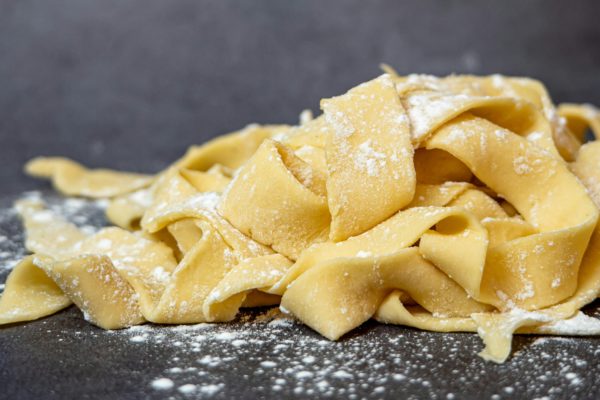
- Italian-style portion: 100g
- UK-style portion: 125-150g
Fresh pasta pairs beautifully with simple sauces like sage butter or light tomato – letting its flavour and texture shine.
How Much Filled Pasta Per Person?
Think ravioli, tortellini, agnolotti – pasta with delicious fillings like ricotta and spinach, wild mushrooms or slow-cooked meats.
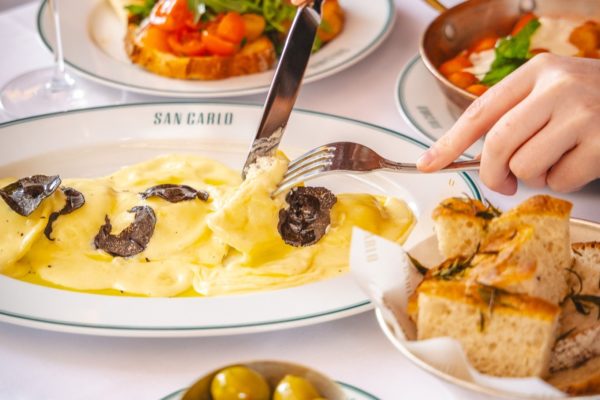
- Italian-style portion: 100-125g
- UK-style portion: 150-175g
Filled pasta is more substantial, so the quantity can be smaller without sacrificing satisfaction.
Specialty Pasta: Gnocchi, Orzo and More
Gnocchi
- Italian-style portion: 80g
- UK-style portion: 120g
Gnocchi is soft, hearty and often richer than other pasta, so portions tend to be smaller.
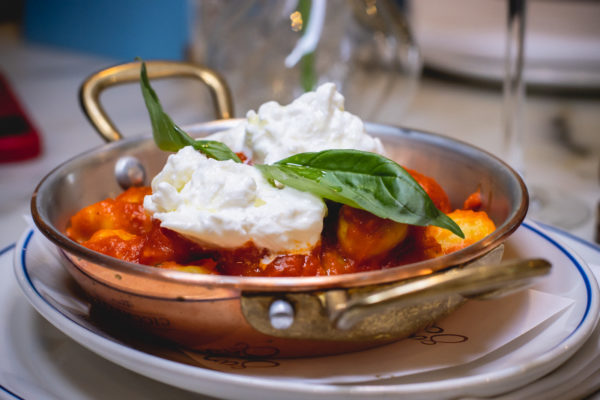
Orzo
- Italian-style portion: 75g
- UK-style portion: 100-120g
Orzo is ideal for soups and salads. It expands when cooked, so a little goes a long way.
From Our Italian Kitchen: Portioning Like a True Italian
In Italy, pasta is rarely the main meal. Instead, it’s the primo – a first course that follows an antipasto and precedes the secondo (main course). A true Italian portion is modest, balanced and meant to be enjoyed as part of a longer dining experience.
So if you’re serving pasta the Italian way, keep your portions light – 75g of dry pasta or 100g of fresh – and complement the meal with a beautiful main, a seasonal contorno (side) and a crisp glass of wine.
Adjusting Pasta Portions: A Handy Guide
Depending on who’s dining, here’s how to adjust your portions:
- Children (under 12): 40-60g of dry pasta
- Adults (light meal or as a starter): 70-90g
- Adults (main meal): 100-120g
- Hungry guests or athletes: 130-150g
Final Thoughts: Portioning Pasta With Confidence
Knowing how much pasta per person to serve means no more guesswork – just delicious, well-balanced meals.
Remember:
- Dry pasta expands significantly when cooked (up to 2.5x)
- Fresh pasta is richer and more filling per gram
- Filled and specialty pastas require slightly different measurements
There’s nothing like pasta prepared by those who’ve mastered the art. Join us at San Carlo and enjoy an unforgettable Italian dining experience – where every dish is perfectly portioned, passionately made and beautifully served.
Manchester Pride Weekend 2025 at San Carlo: What’s On
Manchester Pride is almost here, and we’re turning up the celebrations across San Carlo restaurants.
At Fumo Manchester, the Pride x Fumo Terrace Party kicks off on Saturday 23rd August from 12-6pm and keeps the energy going all weekend long. Expect sunshine (we’ve ordered it specially), our gelato bike serving sweet scoops, an outdoor bar, and – during the parade – live entertainment with stilts, sax and a DJ bringing the soundtrack to the festivities.

Over at San Carlo Alderley Edge, the weekend starts with DJs on Friday and Saturday, before we slow the tempo a little on Sunday with our famous roasts, served from 12pm alongside a live music duo – the perfect way to round off a Pride weekend.

Meanwhile, San Carlo Liverpool and Fumo Birmingham will be keeping the beats flowing with DJs on both Friday and Saturday, so wherever you’re joining us, there’s a party waiting for you.
From music and entertainment to roasts, cocktails and gelato in the sun, San Carlo is ready to make Pride weekend unforgettable.
How to Host an Italian Dinner Party
There’s something undeniably special about gathering friends and family around the table to enjoy an evening of delicious food, good wine and great conversation. If you’re dreaming of creating that warm, convivial atmosphere Italy is famous for, then hosting an Italian dinner party is the perfect way to do it!
Whether you’re planning an intimate evening for 4 or a festive gathering for 12, crafting the perfect Italian dinner party menu is key to setting the mood and satisfying your guests.
In this guide, we’ll show you how to plan your menu, set the scene and bring la dolce vita to life in your home – or at one of our bespoke Private Dining Rooms.
Planning the Perfect Italian Dinner Party Menu
An authentic Italian dinner is all about balance, flavour and a celebration of high-quality ingredients. A traditional Italian dinner party menu follows a multi-course format, typically consisting of:
- Antipasti (appetisers)
- Primo (first course)
- Secondo (main course)
- Contorni (side dishes)
- Insalata (salad and/or greens)
- Formaggi e Frutti (cheese & fruit)
- Dolce (dessert)
- Caffè & Digestivo (after-dinner drink)
Let’s break each down and explore some classic Italian dinner recipes you can serve.
1. Antipasti: The Italian Welcome
Served before the first main course, start your evening with a spread of simple yet flavour-packed Italian appetizers or antipasto to whet the appetite. Think:
- Antipasto platter or Italian charcuterie board with cured meats, cheeses, olives and grilled vegetables
- Bruschetta al pomodoro with ripe tomatoes, garlic, basil and extra virgin olive oil
- Prosciutto-wrapped melon for a touch of sweet and savoury
These light bites are perfect for guests to nibble on while sipping a glass of Prosecco.
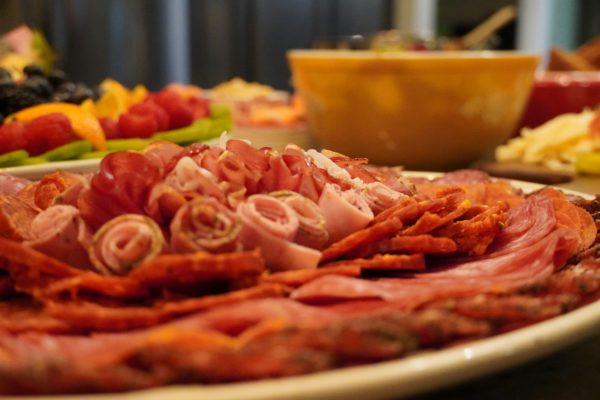
2. Primo: The heart of the meal
The primo course is the first course of the actual meal and typically features a small portion of pasta, risotto or soup. Choose a dish that’s rich and comforting but won’t overshadow the main course.
Some crowd-pleasing options include:
- Spaghetti alle vongole (spaghetti with clams and white wine)
- Risotto ai funghi porcini (porcini mushroom risotto)
- Penne all’arrabbiata (spicy tomato pasta for a little kick)
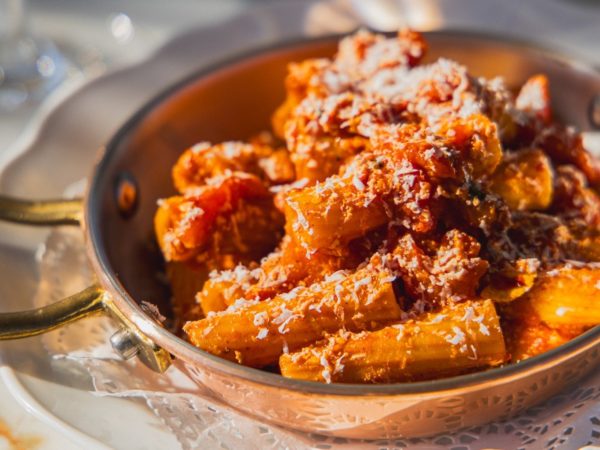
3. Secondo & Contorni: The main event
The secondo is typically a protein-based dish, accompanied by contorni – otherwise known as a side dish of vegetables or salad.
Here are a few elegant combinations:
- Pollo alla cacciatora (hunter-style chicken) with a side of sautéed green beans
- Branzino al forno (whole roasted sea bass) with lemon and rosemary potatoes
- Tagliata di manzo (sliced steak with arugula and parmesan) paired with grilled vegetables
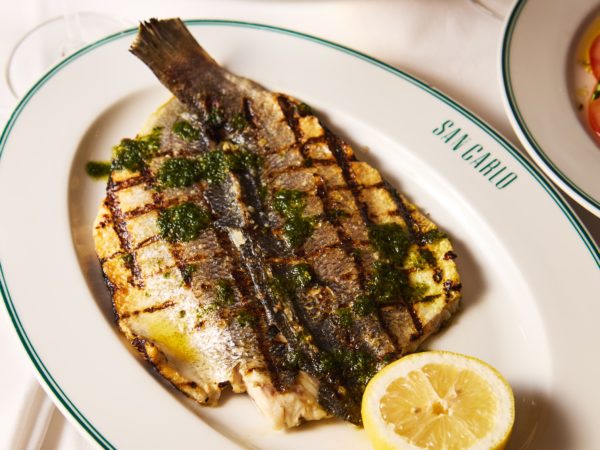
4. Insalata: A fresh palate cleanser
If your contorni don’t include leafy greens, you can serve a simple salad at this stage of the meal – though it’s entirely optional.
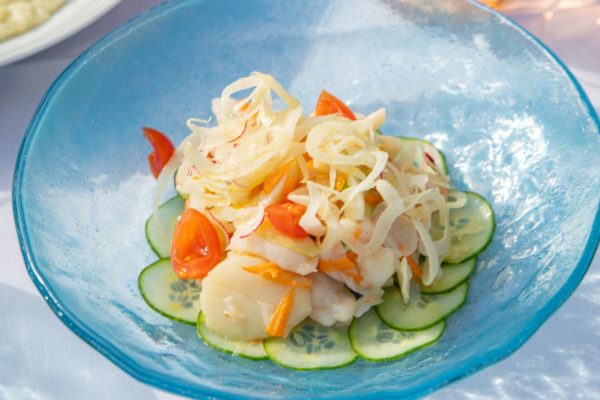
5. Formaggi e Frutti: The precursor to dessert
If you haven’t already for the antipasti course, towards the end of a meal you could choose to serve a cheese board alongside some seasonal fruits.
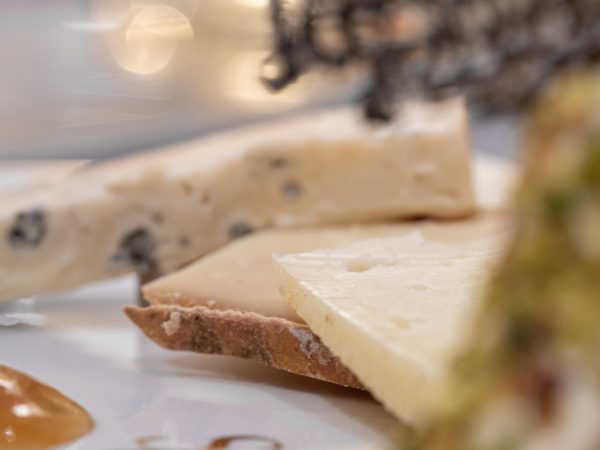
6. Dolce: A sweet finish
End your Italian dinner party on a high note with a classic dessert. Traditional favourites include:
Best pasta dishes to pair with burrata:
- Tiramisu – creamy, coffee-soaked perfection. Discover our perfect tiramisu recipe
- Panna cotta – with berries or a balsamic glaze
- Affogato al caffè – a scoop of gelato “drowned” in espresso
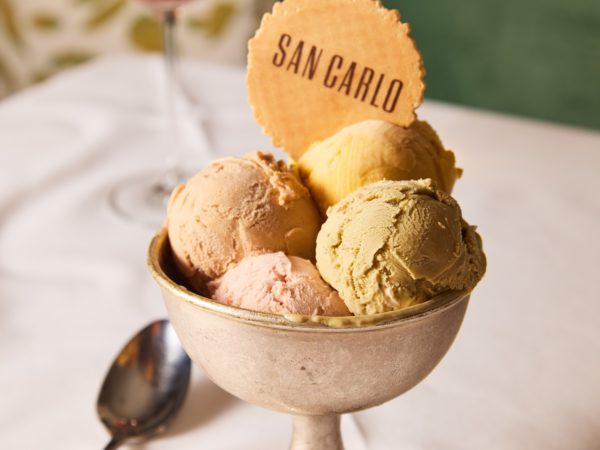
7. Caffè & Digestivo: The final touch
Pair your dessert with a strong coffee such as espresso, a sweet wine or a shot of limoncello for the ultimate Italian experience.

Italian Dinner Party Ideas: Setting the Scene
Once your Italian dinner party menu is in place, turn your attention to creating a relaxed and inviting ambience. Here are a few easy Italian dinner party ideas:
- Decor – Use rustic table settings with white linens, candles, fresh herbs and perhaps a bottle of olive oil or balsamic as centrepieces. For an added touch, a printed menu card for each guest can be an elegant edition to the table. Make sure there is enough space in the middle of the table for guests to self-serve from larger, sharing plates of food in the centre of the table.
- Setting – This kind of meal naturally calls for dining al fresco – a backyard patio would be the perfect place to host and allow guests to immerse themselves in the natural surroundings.
- Music – Create a playlist of classic Italian tunes – think Andrea Bocelli, Eros Ramazzotti or soft instrumental mandolin music.
- Drinks – Offer your guests a selection of Italian wines (Chianti, Barolo, Pinot Grigio) or an Italian Spritz Cocktail and end the night with a digestivo like Grappa or Amaro.
Hosting Tips for an Unforgettable Night
Here are a few practical dinner party planning tips to ensure everything runs smoothly:
- Plan ahead – Prepare as much as you can in advance so you’re not spending a lot of time in the kitchen once your guests have arrived.
- Keep it simple – Focus on quality ingredients and straightforward recipes – the Italian way.
- Serve family-style – Encourage guests to pass platters around the table. It fosters connection and feels authentically Italian.
Final Thoughts
A well-curated Italian dinner party menu is about more than just food – it’s about creating memories, sharing stories and enjoying the moment. With a bit of planning and a passion for Italian cuisine, you can bring the warmth of Italy right to your own table.
A Taste of Italy at Lunchtime – New Menus Now Available
We’re excited to launch our brand-new lunch menus, available Monday to Friday, 12pm–4pm, across a range of our restaurants.
Whether you’re looking to elevate your weekday lunch or take a well-deserved break with friends or colleagues, our new menus are designed to bring a touch of Italian indulgence to your midday.
At San Carlo restaurants, enjoy a carefully curated selection of antipasti & main dishes with:
- 2 courses from £22.95*
- 3 courses from £28.95*
Choose from signature favourites like Rigatoni alla Norma & Pollo Milanese, to seasonal dishes including Trofie Pesto & Chicken Caesar Salad.
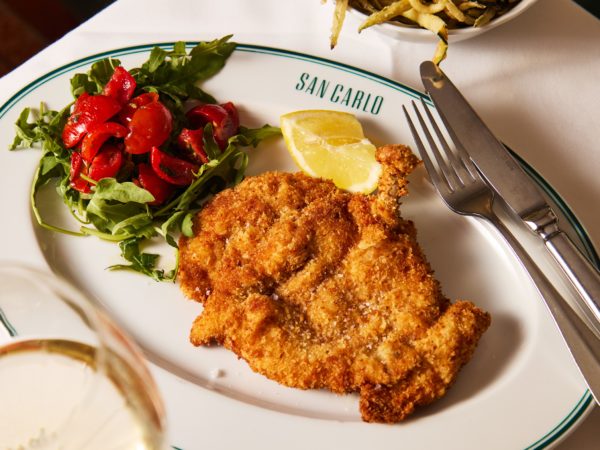
Fancy something sweet to finish? (We’ll never say no to a tiramisu).
Meanwhile, at selected Cicchetti & Fumo locations, you can enjoy:
- 3 dishes from £20.95*
Inspired by the bustling bars of Venice, our small plates are the perfect option for sharing lunches and those who love to try a bit of everything.
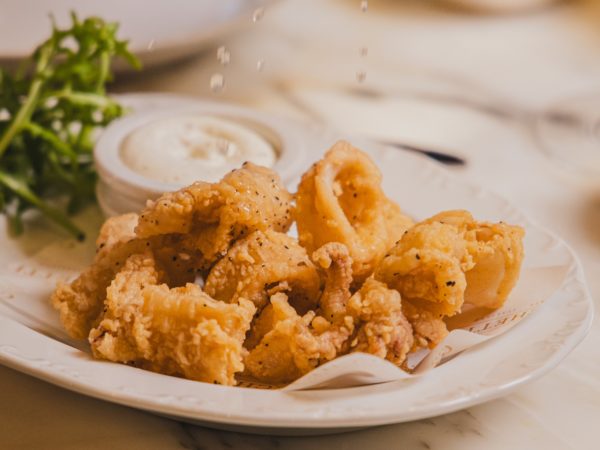
From silky fresh pasta and artisan antipasti to bold regional dishes – there’s something to tempt every appetite. Why not treat yourself to a refreshing spritz for only £10.50? Choose from a Limoncello Spritz or an Aperol Spritz. Alternatively, enjoy a glass of Remigio Rosso or Remigio Bianco for just £6 when ordering from the lunch menu.

From classic antipasti and fresh pasta to mains inspired by the regions of Italy, our lunch menus are a celebration of bold flavours, the freshest ingredients and timeless Italian hospitality.
*Please Note: Menu items & pricing may vary by location. For full details, you can view all of our available lunch menus here.
Ready to make lunchtime plans? Gather your friends, reserve your table and experience lunch the San Carlo way.
Fumo Waterloo Street Joins Birmingham Restaurant Festival With Exclusive Set Menu
We are proud to announce Fumo Waterloo Street is taking part in Birmingham Restaurant Festival, taking place this year in August.
Starting on Sunday 3rd August, from Sunday – Thursday guests can enjoy a specially curated menu that showcases the very best of Fumo’s signature Italian dishes – perfect for sharing, savouring, and celebrating.
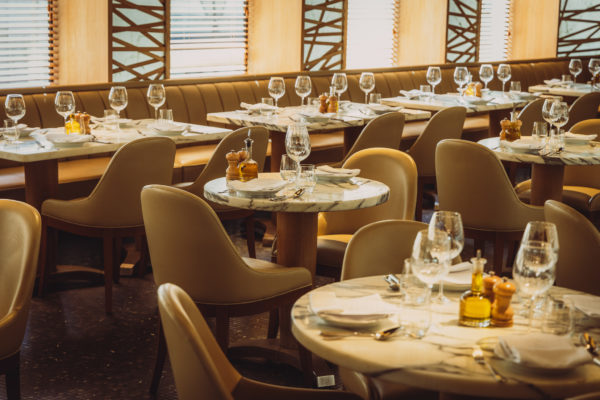
Designed for two to share, the offer includes four dishes from a handpicked selection of favourites such as our creamy spaghetti carbonara, crisp calamari, classic pizza, and indulgent arancini filled with rich beef ragu. To add a seasonal twist, we’re also including the vibrant trofie pesto pasta, bringing summer flavours straight to your table.
-
Lunch Offering – £17.45pp
-
Dinner Offering – £19.45pp
Want to end on a sweet note? Add a decadent dessert for just £6 per person – our house-made tiramisu is always a crowd-pleaser.
Whether you’re planning a midweek catch-up, a leisurely lunch, or simply craving a taste of Italy, your table at Fumo is waiting. But be quick – this exclusive menu is only available for a limited time.
Book a table today and experience Italian dining at its most elegant during Birmingham Restaurant Festival.
Sip to the Sound of the City: Our New Selfridges Cocktail Menu
We have partnered with Selfridges to launch a bold, rhythmic new cocktail menu in celebration of the Selfridges Summer of Sound campaign – exclusively available at our Selfridges restaurants only.
Crafted to reflect the vibrant musical legacy of Manchester, London & Birmingham, our limited-edition Summer of Sound cocktail menu features three original serves – each inspired by a hometown legend, each mixed to the beat of summer.
First up is ‘Nova Fizz’ – a smooth, effervescent tribute to Oasis and the 90s Britpop scene. This cocktail blends Amazzoni Gin, Noilly Prat Dry, champagne syrup, lemon juice and sugar syrup, shaken and double strained for a velvety finish. Garnished with a starburst marshmallow, it’s a fizzy celebration of anthems, attitude and rock ‘n’ roll energy.
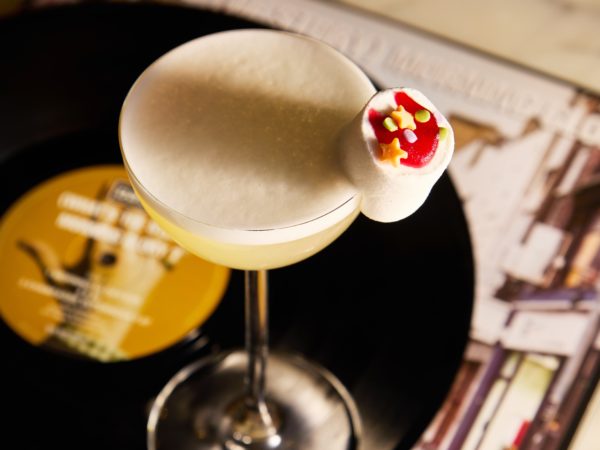
Honouring Coldplay and their luminous rise from London, ‘It Was All Yellow’ mixes Cazcabel Honey Tequila, Patrón Silver, pineapple & lemon juice and chamomile tea. A mellow-meets-zesty moment made for golden hour sipping, this cocktail is smooth, soothing and subtly complex – just like the melodies that inspired it.
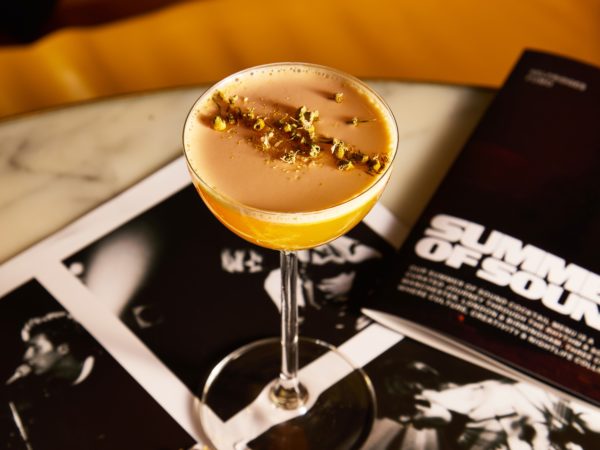
Finally we have ‘Sunrise Beach’ – like the Duran Duran classic it’s named after, this cocktail bursts with colour and vibrancy. Made with Vulcanica Vodka, cranberry juice, lime juice, grenadine, sugar syrup and topped with lemonade – it’s a bright, refreshing nod to New Wave nostalgia.

Every menu includes a QR code linking to our exclusive San Carlo Summer of Sound Spotify playlist – a hand-picked soundtrack which blends iconic hits from Manchester, London and Birmingham musical legends. Whether you’re enjoying cocktails at home, on a terrace or balcony, it’s designed to lift your mood, stir up nostalgia and pair perfectly with your drink.
Each cocktail recipe will also be featured on the menu, so guests can recreate the experience at home – complete with the sound of the city in their ears.
The new menu is available now, exclusively at the following San Carlo restaurants inside Selfridges: Alto Selfridges, Botegga by San Carlo, Fumo Selfridges Birmingham & Champagne Bar (‘Nova Fizz’ only).
Gelato vs Ice Cream: What’s the Difference & Why It Matters?
Whether it’s a summer afternoon in Milan or a weekend treat in Manchester, nothing captures the joy of indulgence quite like a scoop of something cold and sweet. But when it comes to choosing between gelato and ice cream, many are left wondering – what’s the real difference? At San Carlo, where passion for Italian cuisine runs deep, we believe that understanding the craft behind your dessert makes it all the more delightful. So let’s break down the key differences between gelato and ice cream – and why you’ll always find us reaching for the Italian classic.
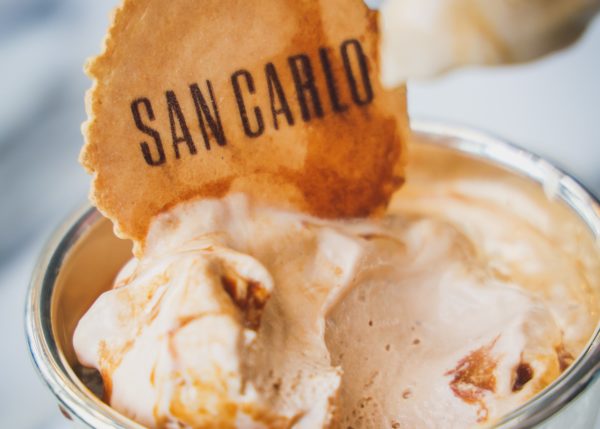
What is gelato?
Gelato is Italy’s answer to ice cream – but it’s more than just a translation. Made with a higher proportion of milk to cream, gelato contains less fat than traditional ice cream. It’s also churned at a slower speed, which incorporates less air, resulting in a texture that’s denser, silkier and far more intense in flavour.
At San Carlo, we serve artisan gelato that reflects the traditions of the Italian gelatieri – smooth, rich and created with ingredients sourced for their authenticity and taste.
What is ice cream?
Ice cream, as we know it in the UK and US, typically contains a higher butterfat content – sometimes up to 20%. It’s churned faster, which means more air is whipped into the mixture. This results in a lighter texture but often dulls the intensity of flavour.
It’s cold and creamy, yes, but after you’ve experienced gelato, it can feel a touch heavy and overly sweet.
Gelato vs Ice Cream: 5 Key Differences
When it comes to gelato vs ice cream, here are the 5 standout differences:
1. Fat Content
- Gelato: Lower in fat, typically around 4-8% due to more milk and less cream.
- Ice Cream: Higher fat content, often between 10-20%, using more cream and sometimes egg yolks.
2. Churning Speed
- Gelato: Churned slowly, incorporating less air, which creates a denser, silkier texture.
- Ice Cream: Churned more quickly, adding more air and resulting in a lighter, fluffier consistency.
3. Serving Temperature
- Gelato: Served at a warmer temperature (around -12°C), enhancing its smoothness and flavour.
- Ice Cream: Served colder (around -18°C), which can make it firmer and slightly dull the taste.
4. Flavour Intensity
- Gelato: Richer and more pronounced flavours, as the lower fat content doesn’t mask the ingredients.
- Ice Cream: Creamier but often milder in taste due to the higher fat content.
5. Texture
- Gelato: Creamy, dense and velvety.
- Ice Cream: Light, airy and more prone to forming ice crystals when stored.
Why Italians Prefer Gelato
For Italians food is about flavour, texture and experience – and gelato delivers all three. Served slightly warmer than ice cream, the flavours shine through more clearly, whether you’re enjoying a scoop of pistacchio or nocciola. The lower fat content means you’re tasting more of the pure ingredients, not just cold cream and sugar.
At San Carlo, we believe in keeping traditions alive – and that includes presenting gelato the way it was meant to be enjoyed: crafted daily, served fresh and always savoured.
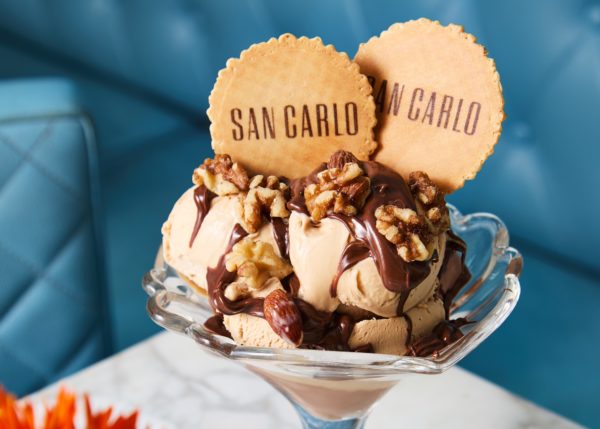
Best Gelato in Manchester
If you’re looking for a taste of Italy in the heart of Manchester City Centre, why not take a trip Gran Cafe Manchester, our Italian patisserie & cafe located in Selfridges, where you can indulge in some of the best gelato sundaes in all of Manchester. All of our gelatos and sorbets are made in-house, using only the best Italian sourced ingredients.
FAQs: Gelato vs Ice Cream
Is gelato healthier than ice cream?
In many ways, yes. Gelato typically contains less fat than ice cream, as it’s made with more milk and less cream. It also uses fewer egg yolks – sometimes none at all – depending on the recipe. Because it’s churned more slowly and served slightly warmer, it has a denser texture and richer flavour, which often means you feel satisfied with less. That said, both are indulgent treats – best enjoyed in moderation and with pleasure.
Why isn’t gelato sold in most stores?
True artisan gelato is best served fresh and that’s part of its charm. It has a shorter shelf life than ice cream and is typically made in small batches. Because gelato is stored at warmer temperatures, it doesn’t travel well in the deep freeze aisles of supermarkets. That’s why you’ll rarely find authentic gelato on the shelves – it’s meant to be savoured in gelaterias or authentic Italian restaurants, where it’s served at its best.
Do Italians eat ice cream or gelato?
Italians are firmly in the gelato camp. While ice cream is more common in other countries, in Italy, gelato is a part of everyday life – whether it’s a mid-afternoon treat, a post-dinner ritual or a stroll-through-the-piazza indulgence. It’s not just dessert – it’s tradition. And at San Carlo, we’re proud to bring that tradition to the UK with every scoop.
Ready to experience Gelato the San Carlo Way?
Book a table at one of our San Carlo locations and you’ll find handcrafted gelato that’s as authentic as it is irresistible. From classic flavours to seasonal sundae specials, each scoop tells a story of Italian artistry and passion.
Because when it comes to dessert, nothing compares to the real Italian experience.
Easy 3 Ingredient Italian Spritz Recipe & Guide
There is no moment more Italian than the aperitivo – that golden hour before dinner when friends gather, conversations flow and glasses clink in celebration of life’s simple pleasures. At the heart of this cherished ritual is the spritz: light, refreshing and beautifully bittersweet.
Join us as we explore 5 beloved Italian spritz cocktails – complete with recipes – that bring a true taste of Italy to your glass!
Different Types Of Italian Spritz
From the iconic Aperol Spritz of Venice to the floral charm of the Hugo, each variation tells a story of place and tradition.
In Italy, the word spritz is more than just a drink – it’s a ritual. Originating in the Veneto region, the spritz began as a simple mix of white wine and soda water. Over time, it evolved into the vibrant, bittersweet cocktails we know today, each one reflecting the character of its region and the spirit of Italian aperitivo culture.
There’s a spritz for every taste: the bright and easygoing Aperol, the bold bitterness of Campari, the refined Select from Venice, the floral Hugo from the north, and the zesty Limoncello of the south.
What is the most popular spritz in Italy?
Without a doubt, the Aperol Spritz reigns supreme – not only in Italy but around the world. Its vibrant orange hue, balanced flavour and refreshing fizz have made it the go-to drink for millions, especially when dining al fresco during the warm summer months.
1. Aperol Spritz Recipe
Bright, bittersweet and beloved across Italy. The Aperol Spritz is the go-to aperitivo.

Recipe:
- 3 parts Prosecco
- 2 parts Aperol
- 1 part soda water
- Serve over ice in a large wine glass
- Garnish with an orange slice
2. Campari Spritz Recipe
For those who like a stronger, more bitter edge, the Campari Spritz is vibrant and sophisticated.

Recipe:
- 3 parts Prosecco
- 2 parts Campari
- 1 part soda water
- Serve over ice in a wine glass or tumbler
- Garnish with an orange wedge or twist
3. Select Spritz Recipe
Hailing from Venice, Select was the original spritz ingredient before Aperol took the spotlight.
Recipe:
- 3 parts Prosecco
- 2 parts Select Aperitivo
- 1 part soda water
- Serve over ice in a wine glass
- Garnish with a green olive for a true Venetian touch
4. Hugo Spritz Recipe
A delicate and refreshing spritz from the South Tyrol region, perfect for summer sipping.

Recipe:
- 3 parts Prosecco
- 2 parts elderflower syrup (or St-Germain)
- 1 part soda water
- Serve over ice in a wine glass
- Garnish with fresh mint leaves and a lime slice
5. Limoncello Spritz Recipe
A southern Italian twist on the spritz, bursting with the zest of lemons from the Amalfi Coast.
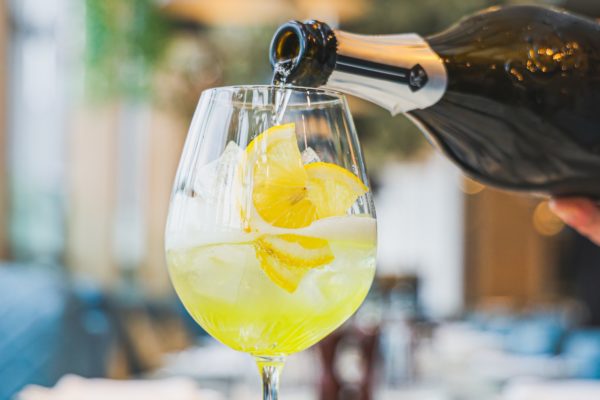
Recipe:
- 2 parts Prosecco
- 1.5 parts Limoncello
- 1 part soda water
- Serve over ice in a wine glass
- Garnish with a lemon wheel and a sprig of basil or mint
FAQs: Everything You Need to Know About Italian Spritz
What alcohol is in Italian spritz?
An Italian spritz typically contains a combination of Prosecco (a dry sparkling wine), a bitter or herbal liqueur (such as Aperol, Campari, Select or Limoncello), and a splash of soda water. The liqueur gives each spritz its distinctive flavour and colour.
What to serve with an Italian spritz?
Spritz is made to be enjoyed with food – it’s the heart of the aperitivo tradition. Light, salty snacks pair best: think olives, crispy focaccia, Italian cured meats, cheese. At San Carlo, we recommend enjoying your spritz with a traditional Italian charcuterie board a selection of classic cicchetti – small Italian plates perfect for sharing.
Is Aperol Spritz Italian?
Yes – the Aperol Spritz is 100% Italian. Aperol was created in Padua in 1919 and the now famous spritz recipe became widely popular in northern Italy before gaining international fame. Today, it’s considered a symbol of the Italian aperitivo.
How to say Aperol Spritz in Italian?
It’s said just as it looks: “Aperol Spritz” – though Italians often shorten it to just “uno Spritz” when ordering at the bar, especially in the north. For example: “Prendo uno Spritz, grazie.”
At San Carlo, we celebrate the art of the aperitivo – so next time you dine with us, raise your glass and toast the Italian way: cin cin!
Father’s Day Meal 2025 at San Carlo
Father’s Day 2025 is fast approaching – and what better way to mark the special occasion than with a memorable meal at San Carlo? Treat dad this year to a delicious Father’s Day feast, whether that be an authentic Italian meal or a traditional Sunday roast dinner – and not forgetting dad’s favourite cocktail. Whatever your plans this 15th June, here’s some ways to show your appreciation for the special man in your life – the San Carlo way.
A La Carte Feast
For a personalised and indulgent Father’s Day meal, explore San Carlo’s extensive A La Carte menu. With a selection of traditional Italian dishes, from perfectly cooked steak, seafood and handmade pasta, to classic risotto & carpaccio, there’s something for every palate. Whether your dad enjoys rich, hearty flavours or light, delicate dishes, our chefs prepare each plate to perfection, ensuring a dining experience he will cherish.

Traditional Father’s Day Sunday Roast
If you’re looking for a more traditional Father’s Day Sunday lunch, our Hale and Alderley Edge venues offer a delectable Sunday Roast Menu alongside the A La Carte options. Enjoy succulent cuts of beef, tender lamb, and flavoursome chicken, all served with crisp roast potatoes, seasonal vegetables, and a generous drizzle of our rich, homemade gravy. Finish your meal with a classic Italian dessert, the perfect sweet touch to a special day.
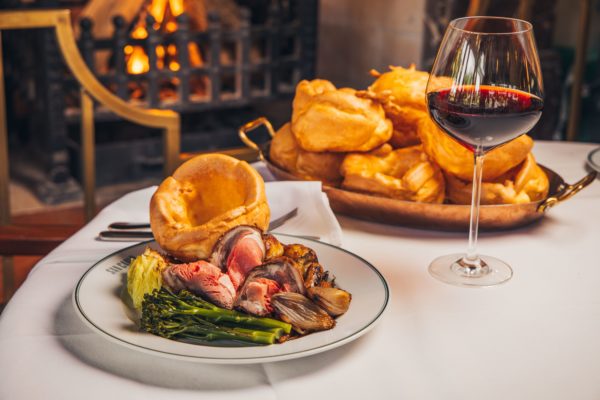
Our Signature Negroni Cocktail
Nothing says ‘Happy Father’s Day’ like a toast to dad with his favourite cocktail. Why not treat him to our bold, signature Negroni cocktail – the perfect drink for the man of the hour.
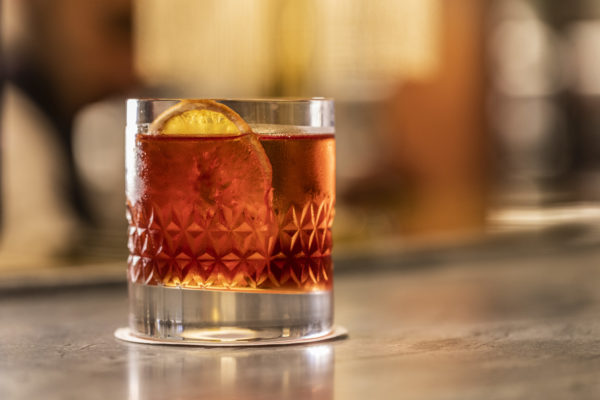
The Perfect Father’s Day Gift – San Carlo Gift Voucher
If you’re looking for a thoughtful gift, a San Carlo Gift Card allows your dad to enjoy the San Carlo experience at his convenience. Whether he chooses a long, indulgent Father’s Day lunch or an evening of fine dining, this gift is a wonderful way to show your appreciation.
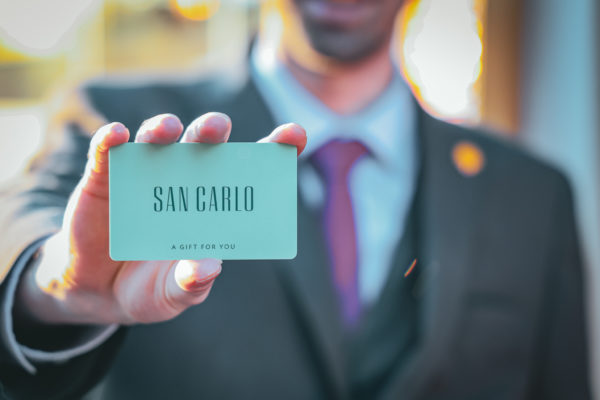
This Father’s Day, gather your loved ones, raise a toast to the incredible father figure in your life, and celebrate in style at San Carlo.
Book Now for Father’s Day 2025
Join My San Carlo Newsletter
Want more from San Carlo? To thank you and show our appreciation for your loyalty, San Carlo Group Restaurants has launched My San Carlo. Benefits include being the first to hear about special events and new dishes, as well as access to news, recipes, competitions and the low down on how to order secret menu items! What are you waiting for? Get started and Join the My San Carlo newsletter today..




